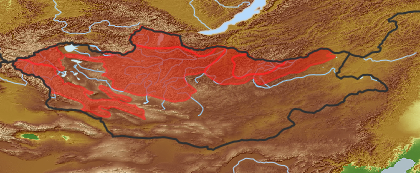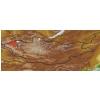| Class: | angiosperms |
| Order: | Caryophyllales |
| Family: | Portulacaceae |
| Genus: | Claytonia |
| Scientific name: | Claytonia joanneana Roem. et Schult. |
| Name acc. to: | Gubanov 1996 |
| Herbar: | list records    |
| Description: | Leaves in radical rosette on long petioles, stem leaves opposite sessile, elliptic to lanceolate. Flowers white or pink, campanulate, 10-15 cm in diameter, pedicellate in terminal racemes. Capsule 3-6 seeded, opening by 3 valves. |
| open map in a new window |  |
| Habitat: | Damp and swampy meadows and bogs, brook banks, bogged rock fields in alpine and subalpine belts, as well as damp and swampy forests at their upper limit (Grubov 2001). |
| Habit (i)general appearance of a plant | |
| Growth form: (i)Herb, shrub, tree or climber. | herb (i)Herbaceous, erect plant, up to 2m high, mostly with a leafy shoot; if perennial, shoots die to the ground each season, shoots are not woody
example: Artemisia pectinata   inherited by family Portulacaceae: herb inherited by family Portulacaceae: herb  inherited by genus Claytonia: herb inherited by genus Claytonia: herb
perennial (i)Living for several to many years, as opposed to annual and biennial  inherited by genus Claytonia: perennial inherited by genus Claytonia: perennial
|
| Size of plant: (i)Attention: use flowering or fruiting specimens to assess plant height (many biennial plants possess only a basal rosette in the first year). | from 100 mm to 250 mm  inherited by family Portulacaceae: inherited by family Portulacaceae:
|
| Parasite status: (i)Is the plant a half- or full parasite? | no parasite/saprophyte (i)Plant fully autonomous, leaves with chlorophyll
example: Most plants, Ranunculus  inherited by family Portulacaceae: no parasite/saprophyte inherited by family Portulacaceae: no parasite/saprophyte
|
| Water or terrestrial plant: (i)Where do the plants grow? | terrestrial (i)Plant grows on dry land
example: Orostachys spinosa  inherited by family Portulacaceae: terrestrial inherited by family Portulacaceae: terrestrial
|
| Leaf (i)expanded, usually photosynthetic organ of a plant (including phylloclades) | |
| Leaf development: (i)Structure and development of leaves. | with green leaves (i)Plant with green leaves  inherited by family Portulacaceae: with green leaves inherited by family Portulacaceae: with green leaves
|
| Leaf arrangement: (i)Arrangement of leaves at the stem. | opposite, opposite-decussate (i)Two leaves per node
example: Lamiaceae, e.g. Phlomis    inherited by family Portulacaceae: opposite, opposite-decussate inherited by family Portulacaceae: opposite, opposite-decussate
basal rosette (i)Leaves positioned at the base of the stem; stem often without leaves, no visible internodes (but flowers often on erect stems, and these may have few leaves)
example: Limonium, Potentilla, Plantago; also used in Liliales with basaly crouwded leaves (Tofieldia, Zigadenus etc.)   inherited by genus Claytonia: basal rosette inherited by genus Claytonia: basal rosette
|
| Simple or divided leaves: (i)Are the leaves simple or completely divided in several parts? Blade of the leaf entire or (more or less) deeply dissected. Attention: There are various appearances of the leaf margin (from entire to toothed and lobed). Here, we ignore this and ask only for dissections that separate the leaf for more than one third of its length or width, whatever is smaller. Sometimes, it is difficult to tell apart compound leaves from a shoot system with simple leaves: look for stipulae and/or axillary buds at the ground of the leaves: if only some possess these structures, the others are most likely leaflets of a compound leaf. | simple (i)Non-divided leaf, but margin may be incised nearly to the ground   inherited by family Portulacaceae: simple inherited by family Portulacaceae: simple
|
| Leaf margin: (i)Structure of leaf margin (or that of a leaflet in case of compound leaves). Attention: Here we ask for the leaf margin, defined as all those dissections that separate the leaf for less than one third of its length or width, whatever is smaller. To be worked out: how to handle margin of pinnate leaves? | entire (i)Plain margin, not toothed
example: Iris   inherited by family Portulacaceae: entire inherited by family Portulacaceae: entire
|
| Leaf veination: (i)Arrangement of the main veins of a leaf. | pinnate (i)One main vein, several side veins, sometimes inconspicuous
example: Cicerbita     inherited by family Portulacaceae: pinnate inherited by family Portulacaceae: pinnate
|
| Flower (i)reproductive portion of the plant, consisting of sepals, petals, stamens, and pistils | |
| Flower appearance and pollination: (i)General appearance of the flower. | not attractive, wind-pollinated or some water plants (i)Small, colourless or green flowers
example: Betula, grasslike plants: Carex, Setaria, Juncus  inherited by family Portulacaceae: not attractive, wind-pollinated or some water plants inherited by family Portulacaceae: not attractive, wind-pollinated or some water plants
|
| Flower colour: (i)Attention: assess colour of the most colourful parts of the flower, but not of the stamens; be aware of single plants with a mutation (mostly white) on flower colour. | white (i)Most plants of the population white
example: Pleurospermum, Maianthemum  inherited by genus Claytonia: white inherited by genus Claytonia: white
pink (i)Between red and white
example: Centaurium  inherited by genus Claytonia: pink inherited by genus Claytonia: pink
|
| Perianth arrangement: (i)Attention: in some plants, flowers may be dimorphic in different ways (dioecious or gynodioecious). If flowers vary, record the characters of the most showy flowers. | double, different (i)Two types of perianth leaves, differently coloured (sepals: outer periant leaves, usually greenish, and petals: inner perianth leaves, usually coloured)
example: Parnassia    inherited by genus Claytonia: double, different inherited by genus Claytonia: double, different
|
| Flower symmetry: (i)Symmetry of the perianth leaves. Attention: to assess this character, look on sepals, petals and stamens, but neglect carpels and ovary. | radiary, regular (actinomorphic) (i)More than two axis of symmetry
example: Saxifraga: 5; Iris: 3   inherited by family Portulacaceae: radiary, regular (actinomorphic) inherited by family Portulacaceae: radiary, regular (actinomorphic)
|
| Petal / Tepal fusion: (i)To which degree are the petal leaves connected? Petals sympetalous. | free (i)all petal leaves separate from each other
example: Anthriscus  inherited by family Portulacaceae: free inherited by family Portulacaceae: free
|
| Spur: (i)A hollow, slender, sac-like appendage of the perianth leaves, storing nectar. | no spur (i)Flower without appendage
example: Peganum  inherited by family Portulacaceae: no spur inherited by family Portulacaceae: no spur
|
| Stamen fusion: (i)To which degree are the stamens fused? Attention: Whereas the pollen sacs itself are often free., their stalks (filaments) may be fused. Here, we count them as fused if they are together over at least one thirth of their length. | free (i)Stamens with separate bases
example: Malus  inherited by family Portulacaceae: free inherited by family Portulacaceae: free
|
| Style number: (i)Portion of the pistil connecting the stigma to the ovary. | 3  inherited by family Portulacaceae: 3 inherited by family Portulacaceae: 3
5  inherited by family Portulacaceae: 5 inherited by family Portulacaceae: 5
|
| Ovary position: (i)For entirely or partly fused carpels, describe their position in relation to the insertion point of perianth leaves (best done by doing a longitudinal section of a flower). | superior (hypogynous) (i)Base of carpels attached above insertion point of perianth leaves, carpels free or fused
example: Delphinium, Anemone    inherited by genus Claytonia: superior (hypogynous) inherited by genus Claytonia: superior (hypogynous)
|
| Inflorescence (i)flowering part of a plant, describes the arrangement of the flowers on the flowering axis | |
| Inflorescence type: (i)Types of inflorescence. Attention: We here ask for the botanical nomenclature of inflorescences, which is sufficiently complicated. Tick only, if you are certain, or tick all inflorescence types that appear similar of these of the plant in question. | raceme (i)Stalked flowers arranged along a simple main axis, often one by one in the axils of leaves, maturing from bottom upwards
example: Aconitum barbatum   inherited by genus Claytonia: raceme inherited by genus Claytonia: raceme
|
| Fruit (i)the seed bearing organ, with or without adnate parts; a ripened ovary and any other structures which are attached and ripen with it. Aggregate fruits are handled like simple fruits for determination. | |
| Consistency: (i)Fleshy fruits or dry fruits, see dispersal adaptations for further classification. | dry (i)With a dry outer shell, no fleshy parts, but seed (embryo) could be edible  inherited by family Portulacaceae: dry inherited by family Portulacaceae: dry
|
| Type of fruit: (i)Common fruit types (including pseudocarp). | Solitary fruits (i)     inherited by family Portulacaceae: Solitary fruits inherited by family Portulacaceae: Solitary fruits
capsule (i)Dry dehiscent fruit, releasing seeds by slits or holes.
example: Poppy, most Caryophyllaceae, Cerastium, a lot of Scrophulariaceae, Iris (oppened capsule looks like Delphinium), Zygophyllum - it is a very common fruit type     inherited by family Portulacaceae: capsule inherited by family Portulacaceae: capsule
Dehiscent fruits (i)Fruits open along a longitudinale line (except silicula)  inherited by family Portulacaceae: Dehiscent fruits inherited by family Portulacaceae: Dehiscent fruits
|
| Opening of fruit: (i)Mode of dehiscence at maturity to release seeds. | opening along dehiscent line (i)Opening along a preformed line
example: Vicia, Lathyrus: pods  inherited by genus Claytonia: opening along dehiscent line inherited by genus Claytonia: opening along dehiscent line
opening with valves (i)Capsules, siliqua, pods or follicles; opening with two or more dehiscent lines and split off outer parts as valves
example: Alyssum, Arabis: siliqua, Epilobium: four-valved capsule, Arenaria: capsule with three valves.     inherited by genus Claytonia: opening with valves inherited by genus Claytonia: opening with valves
opening / dehiscent (i)Dry? Fruits opening with different types  inherited by family Portulacaceae: opening / dehiscent inherited by family Portulacaceae: opening / dehiscent  inherited by genus Claytonia: opening / dehiscent inherited by genus Claytonia: opening / dehiscent
|
| Seed number: (i)Estimate the number of seeds per fruit, if recognizable seeds are in the fruit (in rare cases a fruit may contain one seeded nuts: rose hip, carex). | 2-6 (i)2-6 single seeds, well recognizable
example: Crataegus: few-seeded berry  inherited by genus Claytonia: 2-6 inherited by genus Claytonia: 2-6
|
| Shoot/Stem (i)a young stem or branch | |
| Spines, thorns or prickles: (i)Shoot with conspicuous spines, thorns or prickles. | spines or thornes (i)Sharp pointed woody structure originating from the plant (thornes derived from a reduced branch, spines from leaves)
example: Prunus spinosa no in Mongolia  inherited by family Portulacaceae: spines or thornes inherited by family Portulacaceae: spines or thornes
|
| Root / shoot below ground (i)plant part below ground (in most cases), including below ground shoots, without leaves | |
| Root type: (i)Organisation of the roots. | allorhizous (i)Plant with a conspicuous tap root, one larger tap root with side roots
example: Dicotyledonae  inherited by order Caryophyllales: allorhizous inherited by order Caryophyllales: allorhizous
|
| Distribution (i)region where the plant is likely to be found | |
| Distribution (Veg. Zones): (i)acc. to Grubov 1952 | Khubsgul (i)In distribution data often named as '1' 
Khentei (i)In distribution data often named as '2' 
Khangai (i)In distribution data often named as '3' 
Mongol-Daurian (i)In distribution data often named as '4' 
Khobdo (i)In distribution data often named as '6' 
Mongolian Altai (i)In distribution data often named as '7' 
acc. to: Gubanov 1996 |
| Distribution Khangay: (i)acc. Flora Khangaya 1989 | II
III
V
|